Existing User Log In
New User Registration
Register for a free account to gain full access to the VGChartz Network and join our thriving community.



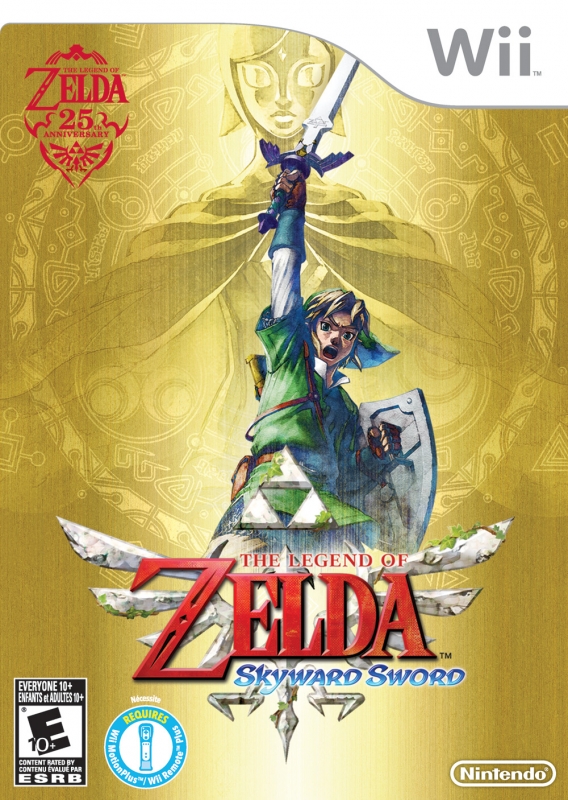

America - Front


America - Back

The Legend of Zelda: four words that hold so much weight for gamers everywhere. Every new entry in the series is analyzed, scrutinized and examined from the moment it is announced and long before most of us will ever get our hands on the final release. Yet despite having to live up to the gold standard that its predecessors have set, every new entry in the franchise has managed to not only meet these lofty expectations but move the series forwards in one way or another. Now, on the eve of Link and Zelda’s 25th anniversary, a new legend is about to be told: the legend of Skyward Sword. Does this latest tale lift the series to new heights or has Nintendo’s golden finish lost some of its lustre?
From the very beginning it’s apparent that you're in for a very different ‘Zelda’ adventure from the ones we've been experiencing over the past 25 years. For starters the fast fields of Hyrule have been replaced with the floating islands of Skyloft. It is here that Link’s latest legend kicks off. We meet up with our hero as he his training to become one of the prestigious Knights of Skyloft, tasked with keeping the peace above the clouds. On the day of the Wing Ceremony - one of the last trials before knighthood - Link’s crimson Loftwing (the big bird from the trailer) mysteriously goes missing.
What ensues is a series of events that will see Link rescue his featured friend from a class bully, compete in the Wing Ceremony and get closer to Zelda than ever before. Soon, however, calamity strikes. While out for a (romantic?) flight around Skyloft, the duo are suddenly caught in a massive storm and Zelda is thrown down into the unknown surface world below. When Link awakens he finds himself with the daunting task of having to not only track down his missing maiden but also save the world below from an ancient evil.
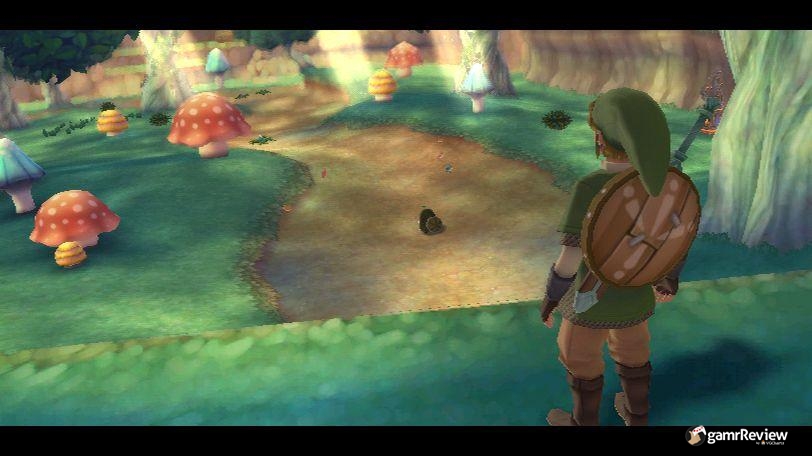
You may be saying to yourself: ‘Hey, this sounds pretty much par for the course for a Zelda game. Zelda is missing, the world is in peril and only Link can save the day’. Well, my rapidly assuming friend, you would be wrong, as The Legend Of Zelda: Skyward Sword takes everything you knew about saving the princess named Zelda and throws it on its head. Everything that we as gamers took as a given over the past 25 years has been completely re-worked, refined and re-imagined to bring The Legend Of Zelda into the 21st century, all the while keeping the series firmly attached to its legendary history.
One of the first things you’ll notice when picking up Skyward Sword is just how much work has gone into making Link, and the world he lives in, things that you actually care about. Skyloft is not Hyrule; it’s a tight-knit community where everybody knows everyone. Link has friends and enemies here - he’s known throughout the entire community. You care about this world, you care about Link, and you care about what happens to Zelda throughout the course of the adventure, something previous titles have, at times, struggled to maintain.
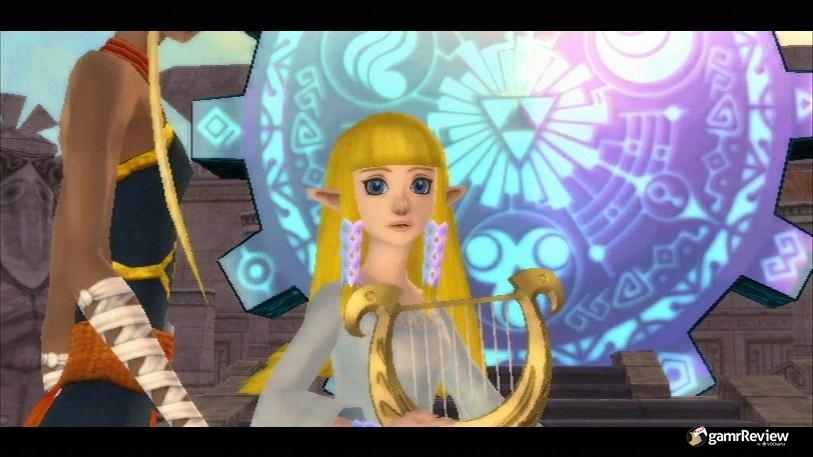
While the Legend Of Zelda games have always allowed players to explore at their own pace, recent titles have received some flak for sticking too closely to the rigid formula of going from overworld to dungeon to overworld to dungeon. Skyward Sword takes a novel approach to this by making the transition between both much more fluid and natural. Skyward Sword also mostly does away with the open world concept seen in past entries. There is still an overworld to explore, packed with secrets, but you will find the only way to get around is to return to Link’s home in the sky and dive to the various areas.
At first glance this may seem like blasphemy for a series that prides itself on its grandeur, but believe me when I say that the world of Skyward Sword is probably the most cohesive, grand and epic world that Link has ever explored. The floating town of Skyloft acts as a sort of hub for Link’s adventures, though it is also where a vast majority of the game's shops, mini-games and side quests take place. The land below the clouds is divided into several regions, each with very different geography and obstacles for Link to tackle. All in all this time around it really doesn’t feel like you are just exploring a vast country, but an entire world.
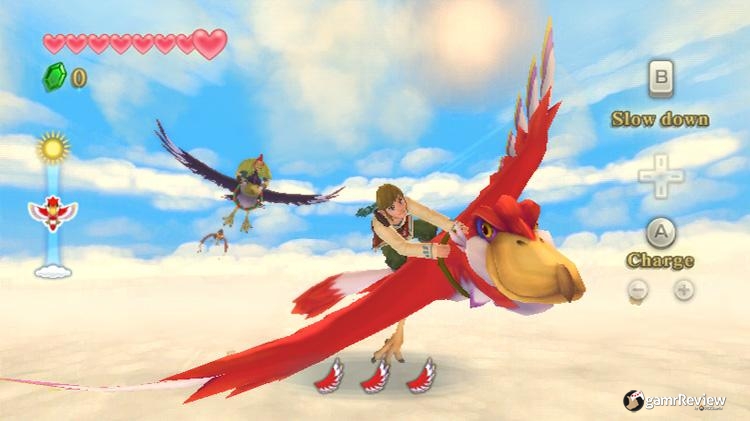
Exploring such a vast and segmented landscape could not be done through traditional means (and by traditional I mean like on horseback or a talking boat). Instead, the landscape is peppered (generously) with bird statues that not only allow you to save your progress (like Majora’s Mask but only you can keep playing) but can also instantly teleport you back to Skyloft. Similarly, when you dive beneath the clouds you can instantly choose to land at any bird statue you have encountered, allowing for seamless transitioning from your home to where you last left your journey down below. Also, you can place ‘beacons’ on your map, which will guide you to your next destination; no hassle, no getting lost.
These are just some of the changes that Nintendo has added to the Zelda formula (see, I told you this wasn’t 'just another Zelda game'). Your partner, Fi, empowers your blade with the ‘dousing’ ability which allows your sword to ‘sense’ objects, like an important character's aura, hidden items, or even health-replenishing hearts. Link is also now blessed with a stamina meter that affects everything from sprinting, to climbing vines, and even his signature spin attack.
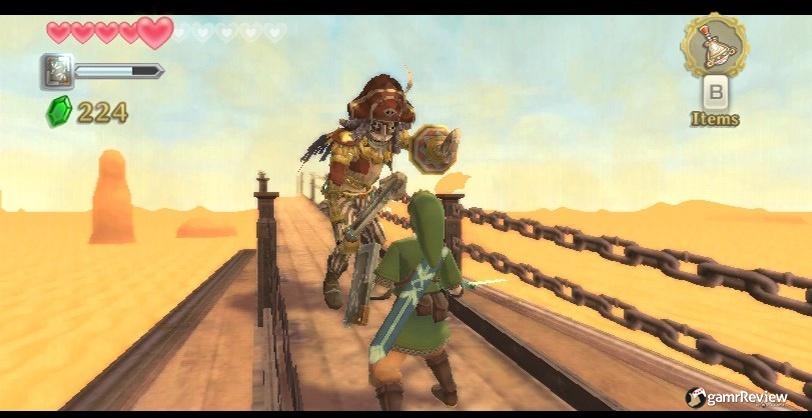
But it’s not just Link who has evolved. Even some of his most recognizable items have undergone radical changes. For instance, your shield now has a ‘health’ meter of its own. Don’t time your deflections well enough? Well, too bad, that’s a busted shield. There's an inventory bag (separate from his larger weapons and items), that's used for items that you need quick access to and can use on the fly, like potions. Finally, one of the most commonly requested changes - upgradeable items - has been implemented at long last.
One last change I would like to share with you is the revamping of one of the franchise's most venerable staples: the dungeon. Like the overworld that leads to them, the temples of Skyward Sword are now much more streamlined than ever before. Gone are the pointless rooms filled with the same puzzles we have been solving since the N.E.S. days, they've been replaced with unique brain teasers that really focus on every part of Link’s inventory (no more one-use items. I'm looking at you, Dominion Rod!).
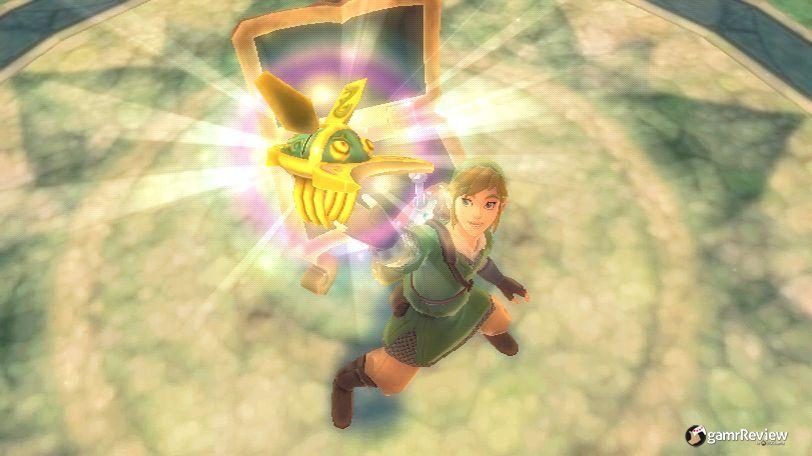
Every single one of these changes, even though they may seem dramatic to those who have been playing the series since the days of ‘Gannon’, rockets the series to new heights. Going into Skyward Sword I was suspicious of Nintendo messing with my beloved Zelda gameplay, but after playing through the game I am a believer. This is a brand new Zelda experience unlike anything you have played before, and just like those first 3D steps we took in Ocarina Of Time, the series is going in a direction from which it can never turn back.
Of course, all of these additions would just be filler if it were not for the ultimate new weapon in Link’s arsenal: Wii Motion Plus. This finally gives us the ability to feel what it is like to wield Link’s blade (and the plethora of other assorted treasures he finds). Wii Motion Plus use goes way beyond just swinging your sword in every direction. Everything from mini-games, Link’s inventory and flying your bird mount through epic scenery is handled with Motion Plus. Not once did I encounter an instance of the game shoe-horning motion controls into unnecessary gameplay elements, and it never feels gimmicky, unlike so many Wii games that have come before it. In Twilight Princess (Wii), Link’s sword was controlled through random waggling of the Wii Remote, which worked fine for a launch title, but Motion Plus takes it to a whole new level. Combat in Zelda has usually been about finding out an opponent’s weakness and exploiting it, but now it's much more involved; you have to recognize openings in an enemy’s defence and position the Wii Remote so your sword strikes exactly at the right angle. This new system is extremely engaging and makes each encounter completely different from the last. Simpy put, Wii Motion Plus is the greatest thing to happen to The Legend Of Zelda… ever.
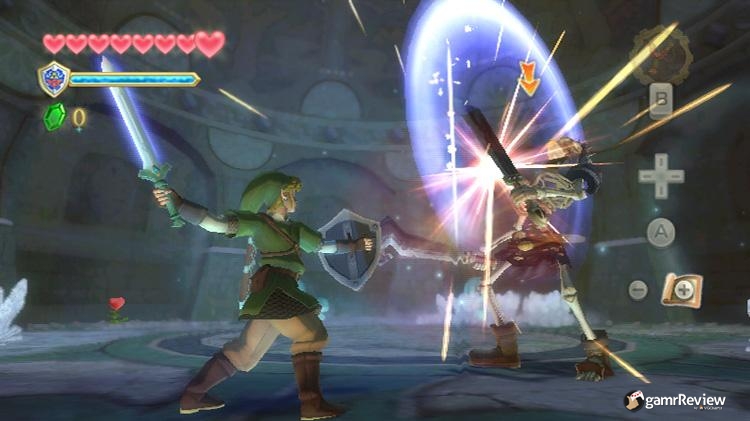
The Nunchuck controller is used to control your shield and spin attack (both via gestures), which feels surprisingly accurate. The oft-neglected microphone on the Wii Remote is also put to good use, adding to the experience by making it sound like you are actually holding the same item that Link is using. The only real drawback here actually lies with the Wii Remote itself, in that it just doesn’t have enough buttons to suite the game’s needs. You can only equip one main item at a time (set to the ‘B’ trigger) and one secondary item (usually a shield or bottle), which forces you to constantly go through your inventory (an issue that was solved as recently as Ocarina Of Time 3D). However, I think the developers may have caught wind of this small problem and lessened the impact by allowing Link to go through his inventory on the fly, without pausing the action.
Superb controls do come at a price. The game uses a hybrid of motion controls and the IR sensor on the Wii Remote as its pointer for menus and ranged weapons, which works wonderfully… when you actually figure out how it works. You see, after five years of simply pointing at the screen with the Wii Remote, it is - at first - awkward to navigate the menus of Skyward Sword. Furthermore, Wii Motion Plus requires re-calibration every so often, which, while not that big of a deal, does lead to a few sighs along the way
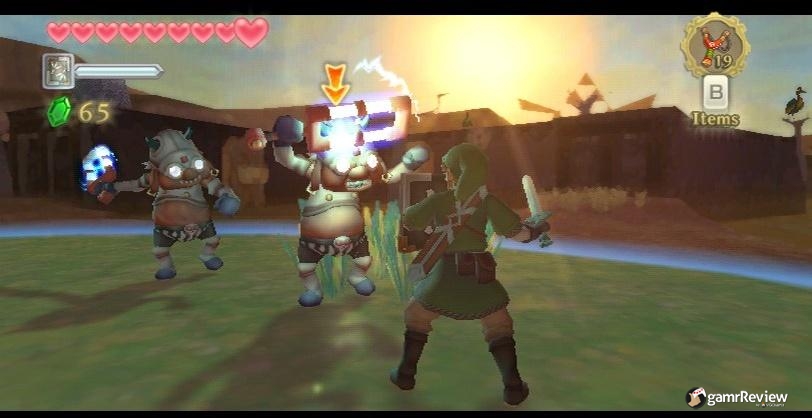
Ever since The Legend Of Zelda: The Wind Waker shocked gamers around the world with its radical new look, the art style used in Zelda games has been subject to much debate. Some people only want to see Link as a dark, mature and brooding hero, while others love the charm that the cel-shaded look brings. Skyward Sword attempts to bridge these two design styles by presenting an older, more mature Link (a la Twilight Princess), with the artistic liberties that we saw in The Wind Waker. This merger of two radically different styles works surprisingly well, however the game does owe a lot more to The Wind Waker than any other Zelda game before it. Both games seem to have the same charm and atmosphere, and never does the game get as dark and melancholic as, say, Twilight Princess, or Majora’s Mask.
The world the Link lives in is bright, vibrant, and alive with color at every turn, yet also just as ‘real’ as his more mature adventures. It’s clear that the development team put a lot of effort into making the game look like ‘a painting come to life’. When you move far away from objects, they begin to blur and start to look like paint strokes, which goes a long way towards covering up some of the Wii’s hardware limitations, which, unfortunately, can still be seen here. Issues like objects popping up in the background are common, as are blurry textures (especially on 2D objects). It is, nonetheless, one of the Wii’s best looking games.
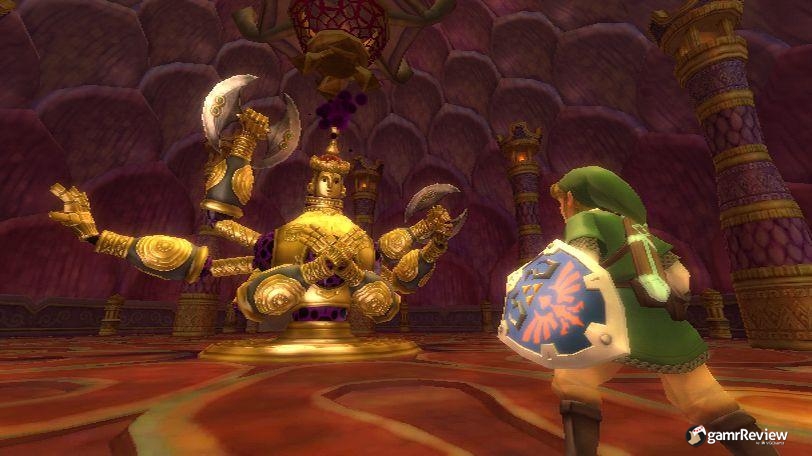
Link is given a more ‘human’ personality, distinct from the silent hero he has always been. This emphasis on character development can also be seen in the game’s numerous (for a Zelda game) cut-scenes and dialogue sequences, which shows that the developers are committed to making the world of Zelda one that gamers actually care about saving. Skyward Sword also introduces us to Fi, Link’s partner in his adventures. Fi is a spirit who lives within Link’s blade and is always ready to help Link… almost too ready. A little advice is nice now and then, but Nintendo went out of their way to make her more annoying than Navi could have ever hoped to be. She speaks in a very logical, almost computer-like narration, and it seems she would be more at home helping Samus than Link.
I don’t believe a Zelda game has ever disappointed in the audio department, so it’s a big step for Skyward Sword to blow away anything that has come before it and all it took was a little addition called… a full orchestra. The theme that plays while soaring around on your Loftwing is a particular favourite of mine. For the most part, what you will be hearing while playing Skyward Sword is absolutely breathtaking, but it is disappointing that Nintendo has not yet embraced the idea of giving the denizens of Link’s world the power of speech, if only because the last few titles in the series have had so much text to read through it can get rather tiring.
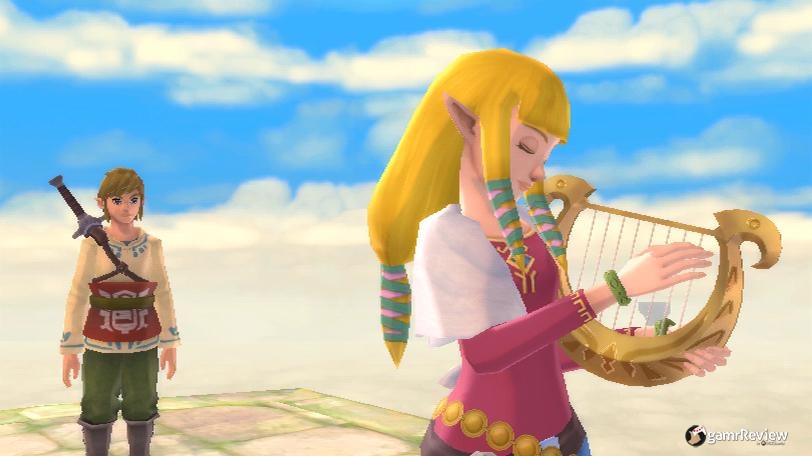
If your goal is simply to complete the main quest, Skyward Sword will last you between 40 and 50 hours, but if you plan on tackling the game’s side quests and collecting all of the treasures, you can easily add another 10 or so hours to your play time. There's also a 'Hero Mode' for you to tackle after you complete the main quest, which is a great addition to a series. Nintendo have also included a soundtrack album with the first printing of the game, featuring tracks from the 25th Anniversary Symphony.
It’s weird to say it, since there have been so many great titles in the series, but The Legend Of Zelda: Skyward Sword is the definitive Zelda experience. It’s exactly what we dreamed about playing 25 years ago. The controls are near perfect, the presentation is breathtaking and you will be enjoying this fantastic title for many, many hours. The Legend Of Zelda: Skyward Sword is a milestone in gaming history. Not only does it move the classic formula that we’ve all grown up with forwards, it also makes us, the players, feel even more attached to the cast than ever before, and finally allows us to ‘feel’ like we're a part of a masterpiece.










|
|
AngryLittleAlchemist
posted 19/07/2017, 12:12
Um...why the heck is this adjusted down? When I joined VGChartz last december this was at like 4.4 million. Message | Report |
|
|
S.Peelman
posted 18/01/2017, 11:26
Isn't this adjusted? It's adjusted, it was over 4m for sure. Adjusted down which is hilareous, because it is most definitely undertracked. VGC already took over a year to match Nintendo's published numbers back in 2012 so this is not exactly credible. Message | Report |
|
|
Nuvendil
posted 22/03/2016, 10:41
You know a franchise has some serious power when you do almost no promotion and your E3 presentations for it are bad and the game launches on a dying platform but the thing STILL sells 4mil, STILL gets nominated for numerous awards, and STILL wins multiple large publications GOTY awards. In the same year Skyrim and Arkham City launched. Message | Report |
|
|
OneTwoThree
posted 01/02/2016, 11:13
I love ths game. Nintendo needs to fix the timing of their Zelda release cycle. You can't release a game of this class and scope right before a console is phased out, when public interest for the system has died down. Message | Report |
|
|
|
|
|
|